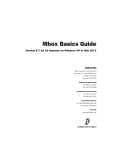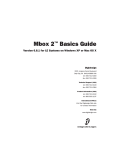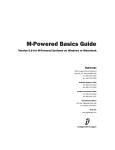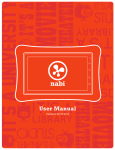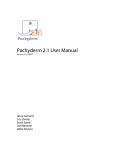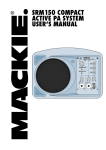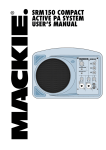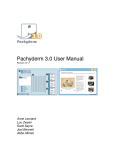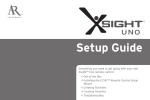Download Avid Technology DIGI 1 Specifications
Transcript
Basics Digi 002® & Digi 002 Rack™ Version 7.0 Copyright © 2005 Digidesign, a division of Avid Technology, Inc. All rights reserved. This guide may not be duplicated in whole or in part without the express written consent of Digidesign. Avid, Digidesign, Digi 002, Digi 002 Rack, and Pro Tools are either trademarks or registered trademarks of Avid Technology, Inc. in the US and other countries. All other trademarks contained herein are the property of their respective owners. Product features, specifications, system requirements and availability are subject to change without notice. PN 9320-17744-00 REV A 10/05 Introduction Welcome to the Digi 002 and Digi 002 Rack Basics Guide. This guide is designed to give new users specific methods for accomplishing common tasks with the Digi 002 or Digi 002 Rack desktop audio interface and Pro Tools LE software. Once you are familiar with basic Digi 002 and Digi 002 Rack operation, we recommend that you read the “Working With Pro Tools” tutorial in the Digi 002 and Digi 002 Rack Getting Started Guide. For the most complete information on using Pro Tools, see the Pro Tools Reference Guide. Digi 002 and Digi 002 Rack Basics Requirements Before proceeding, make sure you have: • Connected the Digi 002 or Digi 002 Rack to your computer with the FireWire cable – and – • Installed Pro Tools LE software as described in the appropriate Windows or Macintosh installation chapter of the Digi 002 and Digi 002 Rack Getting Started Guide. Online Resources Many resources for learning to use Pro Tools are also available online at the Digidesign Web site (www.digidesign.com), including the following: DiSK (Digidesign Sound Knowledge) Instructional material about how to use Pro Tools, including DiSK Flix movies that show how to do a number of popular tasks using Pro Tools. DigiZine A magazine for and about Pro Tools users, providing all the latest product news, user stories, and hundreds of tips and ideas. Introduction 1 Getting Sound In & Out of Digi 002 or Digi 002 Rack To hear audio recorded into a Pro Tools session, you will need to connect headphones or an external sound system (such as powered monitors or a home stereo) to Digi 002 or Digi 002 Rack. Sound from Digi 002 and Digi 002 Rack cannot be played through your computer’s speakers or your computer’s sound output. Connecting Headphones There is one headphone jack, a stereo 1/4-inch plug, on the Digi 002 and Digi 002 Rack. MONO MUTE MONITOR LEVEL HEADPHONE LEVEL Headphone Level knob 1/4-inch Headphone jack Headphone jack (located on the top panel of Digi 002, and on the front panel of Digi 002 Rack) To connect headphones: Connecting a Sound System The monitor outputs (labeled “Mon”) on the back of the Digi 002 and Digi 002 Rack support 1/4-inch plugs. These connections can be balanced, TRS (Tip, Ring, Sleeve) style connectors, or unbalanced connectors. To listen to your Pro Tools session, these outputs can be connected to any amplification system: powered speakers, a home stereo system, or an audio mixer. When connecting to a stereo system, connect the left channel (often the white plug) to Mon Output L, and right channel (often the red plug) to Mon Output R. “Mon” is short for Monitor. Home stereo systems often use RCA connectors. You can use an adaptor or a special cable to convert from the TRS or TS connectors used by Digi 002 and Digi 002 Rack to the RCA connectors on your home stereo. • Connect headphones with a 1/4-inch stereo connector (or adapter) to the Headphone jack. Mon Output L (left output) L MAIN L/1 MON OUTPUT L MAIN R/2 MON OUTPUT R Mon Output R (right output) R The Headphone Level knob (located on the top panel of Digi 002, and on the front panel of Digi 002 Rack) adjusts the volume level of the Headphone jack. ALT MAIN UNBAL (-10 dBV OUTPUT) ALT SRC INPUT 964530300294856 SERIAL NUMBER OPTICAL OUT IN MIDI OUT 2 MIDI OUT 1 Monitor Outputs (back panel) Mon Outputs Left and Right play the audio that is routed to analog outputs 1 and 2 within Pro Tools. The Monitor Level knob (located on the top panel of Digi 002, and on the front panel of Digi 002 Rack) adjusts the volume level of the Monitor Outputs. 2 Digi 002 and Digi 002 Rack Basics Guide Connecting Audio Inputs Digi 002 and Digi 002 Rack inputs support microphones, guitars, keyboards, and other types of instruments. Line/Inst Inputs 1–4 LINE/ INST LINE/ INST LINE/ INST MIC MIC MIC LINE/ INST MIC 4 3 2 1 48V 48V Mic Inputs 1–4 Four Mic and Line/Inst Inputs (back panel) INPUT 7 INPUT 8 INPUT 5 +4 -10 +4 -10 INPUT 6 +4 -10 +4 -10 Analog Inputs 5–8 Four Analog Inputs (back panel) Digi 002 and Digi 002 Rack have eight analog inputs. One set of inputs is labeled Mic Inputs 1–4 and Line/Inst Inputs 1–4, and the other four are labeled Inputs 5–8. For stereo inputs, use an odd/even pair of inputs (for example, Input 5 for the left input, and Input 6 for the right input. You cannot use both a Mic Input and Line/Inst Input with the same input number at the same time. For information about connecting specific audio sources, see “Connecting a Microphone to the Digi 002 or Digi 002 Rack” on page 4, and “Connecting Instruments to the Digi 002 or Digi 002 Rack” on page 6. Getting Sound In & Out of Digi 002 or Digi 002 Rack 3 Connecting a Microphone There are several ways to use Digi 002 or Digi 002 Rack with a microphone, depending on the type of microphone and cables you use. Mic Cables and Connectors Some microphone cables use an XLR connector to attach a microphone to an input (such as those on the Digi 002 and Digi 002 Rack); other microphones use a 1/4-inch connector. If you have a choice, use an XLR connector to connect the microphone to the Digi 002 or Digi 002 Rack to yield better results. XLR connector Most condenser microphones (such as an AKG C3000) require phantom power to operate. Dynamic microphones (such as a Shure SM57) do not require phantom power to operate, but are not harmed by it. Although phantom power can be used safely with most microphones, it is possible to damage some ribbon microphones with it. Always turn off phantom power and wait at least ten seconds before connecting a ribbon microphone. The Digi 002 and Digi 002 Rack can only supply power through a microphone cable with XLR connectors. If you are not sure about the phantom power requirements for your microphone, refer to your microphone’s documentation or contact the manufacturer. 1/4-inch connector XLR and 1/4-inch connectors Phantom Power Some microphones require power to operate. This power, called phantom power, is supplied either by a battery in the microphone, or through an audio interface (such as Digi 002 and Digi 002 Rack) that can supply power through the microphone cable. Connecting a Microphone to the Digi 002 or Digi 002 Rack To use a microphone that has an XLR connector: 1 Plug your microphone cable into one of the Mic inputs on the back of Digi 002 or Digi 002 Rack. The inputs are numbered right to left, so Mic Input 1 is the rightmost input. NPUT 5 NPUT 6 +4 -10 +4 -10 LINE/ INST LINE/ INST LINE/ INST MIC MIC MIC MIC 4 3 2 1 48V LINE/ INST 48V Mic Input 1 XLR connector plugged into Mic Input 1 4 Digi 002 and Digi 002 Rack Basics Guide 2 Press the Line/Inst and Mic Selector switch (located on the top panel of the Digi 002, and on the front panel of the Digi 002 Rack) for the corresponding input so that it is in the “Mic” (down) position. Line/Inst and Mic Selector switches (Mic position is down) To use a microphone that has a 1/4-inch connector: 1 On the back of the Digi 002 or Digi 002 Rack, plug the 1/4-inch connector from your microphone into one of the Line/Inst inputs. The inputs are numbered right to left, so Line/Inst Input 1 is the rightmost input. Line/Inst Input 1 LINE/ INST MIC ST LINE/ INST LINE/ INST 1 GAIN 2 GAIN 3 GAIN LINE/ INST 48V 48V MIC MIC MIC 3 2 1 4 GAIN Line/Inst and Mic Selector switches (located on the front panel of Digi 002, and top panel of Digi 002 Rack) 3 If your microphone requires phantom power, make sure the microphone is connected, then press the Phantom Power switch on the back of the Digi 002 or Digi 002 Rack (labeled 48V) for the corresponding input pair. Each Phantom Power switch sends 48V to its corresponding input pair. 1/4-inch connector plugged into Line/Inst Input 1 2 Press the Line/Inst and Mic Selector switch (located on the top panel of the Digi 002, and on the front panel of the Digi 002 Rack) for the corresponding input so that it is in the “Line/Inst” (up) position. Line/Inst and Mic Selector switches (Line/Inst position is up) LINE/ INST Phantom Power (Mic Inputs 1 and 2) LINE/ INST LINE/ INST LINE/ INST MIC MIC MIC MIC 4 3 2 1 MIC LINE/ INST 48V 48V Phantom Power (Mic Inputs 3 and 4) Phantom Power switches (back panel) 4 When Pro Tools is launched and the input is routed to a Pro Tools track (see “Recording a Pro Tools Session” on page 8), you can adjust the input level with the Gain knob on the top panel of the Digi 002, and the front panel of the Digi 002 Rack. 1 GAIN 2 GAIN 3 GAIN 4 GAIN Line/Inst and Mic Selector switches (located on the front panel of Digi 002, and top panel of Digi 002 Rack) If you are using a microphone with a 1/4inch connector, do not choose the “Mic” input source because the Digi 002 or Digi 002 Rack will not register any signal. 3 When Pro Tools is launched and the input is routed to a Pro Tools track (see “Recording a Pro Tools Session” on page 8), you can adjust the input level with the Gain knob on the top panel of the Digi 002, and the front panel of the Digi 002 Rack. Connecting a Microphone 5 Connecting Instruments Connecting Instruments to the Digi 002 or Digi 002 Rack Digi 002 and Digi 002 Rack support two types of inputs, which correspond to the signal strengths output by different types of instruments. Instruments such as electric guitar or electric bass usually have a lower level of output than instruments and electronic audio sources such as mixers, samplers, keyboards, turntables, and synthesizers. The higher level of output is commonly called “line-level” and the instruments that produce these higher levels are called line-level devices. On the Digi 002 and Digi 002 Rack, Line/Inst Inputs 1–4 support low-level instruments and linelevel instruments. Analog Inputs 5–8 support line-level instruments only. To use a guitar with Digi 002 or Digi 002 Rack: 1 Plug your guitar cable into one of the Line/Inst inputs on the back of the Digi 002 or Digi 002 Rack. The inputs are numbered right to left, so Line/Inst Input 1 is the rightmost input. Line/Inst Input 1 ST LINE/ INST LINE/ INST LINE/ INST 48V 48V MIC MIC MIC 3 2 1 Guitar cable plugged into Mic Input 1 6 Digi 002 and Digi 002 Rack Basics Guide 2 Press the Line/Inst and Mic Selector switch (located on the top panel of the Digi 002, and on the front panel of the Digi 002 Rack) for the corresponding input so that it is in the “Line/Inst” (up) position. Line/Inst and Mic Selector switches (Line/Inst position is up) LINE/ INST MIC 1 GAIN 2 GAIN 3 GAIN 4 GAIN Line/Inst and Mic Selector switches (located on the front panel of Digi 002, and top panel of Digi 002 Rack) 3 When Pro Tools is launched and the input is routed to a Pro Tools track (see “Recording a Pro Tools Session” on page 8), you can adjust the input level with the Gain knob on the top panel of the Digi 002, and the front panel of the Digi 002 Rack. To use a keyboard or mixer with Digi 002 or Digi 002 Rack: 1 Plug your keyboard, mixer, or other audio source into any of the Line/Inst inputs or analog Inputs on the back of your Digi 002 or Digi 002 Rack. For stereo inputs, (such as a stereo keyboard or the stereo output from a mixer), use an odd/even pair of inputs. For example, connect the left channel (often the white plug) to Line/Inst 1, and right channel (often the red plug) to Line/Inst 2. The Line/Inst inputs are numbered right to left, so Line/Inst Input 1 is the rightmost input. Line/Inst Inputs 1–4 0 +4 -10 LINE/ INST LINE/ INST LINE/ INST MIC MIC MIC MIC 4 3 2 1 Line/Inst and Mic Selector switch (located on the top panel of the Digi 002, and on the front panel of the Digi 002 Rack) for each corresponding input so that it is in the “Line/Inst” (up) position. Line/Inst and Mic Selector switches (Line/Inst position is up) LINE/ INST MIC 1 GAIN 2 GAIN 3 GAIN 4 GAIN Line/Inst and Mic Selector switches (located on the front panel of Digi 002, and top panel of Digi 002 Rack) For line-level devices, the Gain knob should be turned down all the way. LINE/ INST 48V 48V 2 If you are using any Line/Inst inputs, press the 3 If you are using any of the Inputs 5–8, set ei- Line/Inst Inputs (back panel) The analog Inputs are numbered top to bottom, in pairs. INPUT 7 INPUT 8 ther a –10 dBV or +4 dBu operating level for the corresponding input using the Operating Level switch on the back panel. For information on the appropriate operating level for your input device, refer to the manufacturer’s specifications. INPUT 5 +4 -10 +4 -10 INPUT 6 +4 -10 +4 -10 INPUT 7 INPUT 5 Analog Inputs 5–8 INPUT 8 Analog Inputs (back panel) +4 -10 +4 -10 INPUT 6 +4 -10 +4 -10 Operating Level switches Line Inputs 5–8 (back panel) 4 Set your instrument’s volume to its optimal level. For example, the optimal level for most keyboards is between 80% and 100% of maximum volume. Connecting Instruments 7 Recording a Pro Tools Session Before you record with the Digi 002 or Digi 002 Rack, you first create a Pro Tools session, then prepare an audio track for recording. To prepare an audio track for recording: 1 Choose Track > New. 2 Specify 1 Mono Audio Track in Samples, if To create a Pro Tools session: 1 Verify the connections between the Digi 002 or Digi 002 Rack and your instrument or microphone. your source is mono, or 1 Stereo Audio Track in Samples, if your source is stereo. 2 Launch Pro Tools. 3 Choose File > New Session. 4 In the New Session dialog, set the session pa- rameters as needed, or leave them at their default settings. (For details on New Session settings, see the Digi 002 and Digi 002 Rack Getting Started Guide.) Creating a new Stereo audio track 3 Click Create. A mono instrument uses one input on the Digi 002 or Digi 002 Rack, and a stereo instrument uses two. Creating a stereo track in Pro Tools will not make a mono instrument into a stereo instrument. If a mono instrument is recorded on a stereo track, one side of the stereo track will show no signal. 4 Make sure the Mix window is open by choos- ing Window > Mix. Showing the Mix window 5 In the Mix window, click the Input Selector on New Session dialog the new track. 5 Choose where you want to save your session. 6 Type a name for your session. Input selector 7 Click Save. Choosing an input in the Mix window 8 Digi 002 and Digi 002 Rack Basics Guide 6 From the pop-up menu, select the interface in- put you want to record. For example, select Mic/Line 1 if your audio source is plugged into either the Mic Input 1 or Line/Inst Input 1 jack on the back of the Digi 002 or Digi 002 Rack. Select Mic/Line 1–2 on any stereo audio track when your audio source is stereo. To record an audio track: 1 Click the Track Record Enable button. Record enabling a track in the Mix window 2 Choose Window > Transport to display the Transport window. Click Return to Zero to go to the beginning of the session. Return to Zero Fast Forward Play Rewind Routing an input to a mono track Online Stop Go to End Record Enable 7 Play the instrument or sound source at the volume you will record. 8 Use the Gain controls on the Digi 002 or Digi 002 Rack to maximize the signal going into Pro Tools while avoiding clipping. Clipping occurs when you feed a signal to an audio device that is louder than the circuitry can accept. To avoid clipping, adjust the Gain control to a level where the Peak LEDs (located on the top panel of Digi 002, and on the front panel of Digi 002 Rack) flicker occasionally. For line-level devices, the Gain knob should be turned down all the way. 9 If you need to lessen the amount of signal delay (latency) that you are hearing, set Pro Tools to Low Latency Monitoring mode. See “Controlling Delay (Latency) During Monitoring” on page 18 for specific steps. Transport window 3 Click Record Enable in the Transport window to arm Pro Tools for recording. The Record button flashes red to indicate that Pro Tools is ready to record. 4 When you are ready to start recording, click Play or press the Spacebar. 5 Record your performance. 6 Click Stop in the Transport window or press the Spacebar when you are finished recording. To play back a recorded track: 1 If the track’s Record Enable button is lit, click on it to take it out of Record mode. 2 Click Play in the Transport window or press the Spacebar to start playback. 3 Click Stop in the Transport window or press the Spacebar to stop playback. Recording a Pro Tools Session 9 Impor ting Audio from a CD To import audio from a compact disc: 1 Launch Pro Tools. 2 Choose File > New Session. 7 Open the Workspace browser by choosing Window > Workspace. The Workspace browser is a window where you can find, audition, and manage your audio files. 3 Set Session Parameters in the New Session dialog as needed, or leave at their default settings. (For details, see the Digi 002 and Digi 002 Rack Getting Started Guide.) Opening the Workspace browser 8 In the Workspace browser, click the Audio CD icon to show the files on the CD. 9 Click the speaker icon in the Waveform col- umn to audition the audio file. Press the Spacebar to stop playback. New Session dialog 4 Choose where you want to save your session. 5 Type a name for your session and click Save. 6 Put the source CD into your computer’s CD drive. 10 Digi 002 and Digi 002 Rack Basics Guide Auditioning an audio file in the Workspace browser 10 Drag the audio file from the Workspace browser to the Track List in the Edit window to import the file to a new audio track. Dragging an audio file from the Workspace browser to the Edit window Track List To play back the new track: 1 In the Transport window, click Return to Zero to go to the beginning of the track. 2 Click Play in the Transport window or press the Spacebar to start playback. 3 Click Stop in the Transport window or press the Spacebar to stop playback. Importing Audio from a CD 11 Creating an Audio CD from a Pro Tools Session Pro Tools does not create audio CDs directly, but you can create stereo audio files from your Pro Tools sessions that can be used by most CD burning software. 2 Choose File > Bounce to > Disk. Bouncing Audio to Disk Use the Pro Tools Bounce to Disk feature to combine all your audible tracks into a single “master” audio file. After the new audio file has been bounced to disk, you can burn it to a CD. If you are bouncing down audio from 24-bit resolution to 16-bit (CD resolution), you should use a dither plug-in on the main output. (For details, see the Digi 002 and Digi 002 Rack Getting Started Guide.) 3 In the Bounce Options dialog, choose Outputs 1–2 as the Bounce Source. 4 Choose BWF (.WAV) for the File Type. To bounce audio to disk: 5 Choose Stereo Interleaved for the Format. 1 After you have finished recording and mixing 6 Choose 16 for the Resolution and 44100 for a session in Pro Tools, select the length of the session in the timeline ruler (or on a track), plus an additional amount of time to avoid cutting off any reverb tails that might continue past the end of the last region. the Sample Rate. Audio session highlighted and ready to bounce 12 Choosing Bounce to Disk from the File menu Digi 002 and Digi 002 Rack Basics Guide 7 If you are changing the sample rate of the bounced file, choose a Conversion Quality setting. (For details, see the Digi 002 and Digi 002 Rack Getting Started Guide.) Pro Tools begins bouncing to disk. Pro Tools bounces are done in real time, so you hear audio playback of your mix during the bounce process (though you cannot adjust it). . 8 Choose “Convert after Bounce,” and click Bounce. Bouncing to Disk dialog Burning a CD After the bounce is completed, you will have an audio file that is ready for burning onto a CD. Quit Pro Tools and launch any common CD burning application to burn your bounced mix to CD. Bounce options for creating CD burnable tracks 9 In the Bounce dialog, give the bounce tracks a name and choose where they should be saved. Make certain that you configure your CD burning application to create an audio CD rather than a data CD. Entering a name for the bounced file 10 Click Save. Creating an Audio CD from a Pro Tools Session 13 Digi 002 & Digi 002 Rack and MIDI 2 Connect another MIDI cable from the What is MIDI? MIDI (Musical Instrument Digital Interface) data is not audio, and has no sound. MIDI is a way for musical devices to communicate. MIDI is data that can trigger a MIDI device (such as a keyboard or software synthesizer.). MIDI In port of your device to the MIDI Out port on the back panel of the Digi 002 or Digi 002 Rack. L In order to create or play a MIDI recording, you must have a MIDI keyboard or sound module (real or virtual) connected to the computer through the MIDI ports on the Digi 002 or Digi 002 Rack, or another MIDI interface. Audio from your MIDI instrument can be monitored through the Digi 002 or Digi 002 Rack, or sent to an external mixer. OUTPUT 3 OUTPUT 4 L MAIN L/1 MON OUTPUT L MAIN R/2 MON OUTPUT R INPUT 7 R INPUT 5 R ALT MAIN UNBAL (-10 dBV OUTPUT) ALT SRC INPUT INPUT 8 +4 -10 +4 -10 INPUT 6 +4 -10 +4 -10 LINE/ INST 964530300294856 MIC SERIAL NUMBER IN OPTICAL OUT IN OUT FOOT SWITCH 1394 LINK 1394 S / PDIF MIDI OUT 2 MIDI OUT 1 MIDI IN 4 MIDI In MIDI Out Monitoring MIDI Instruments with Digi 002 or Digi 002 Rack Audio To amplifier MIDI keyboard (controller) OUTPUT 5 OUTPUT 6 Digi 002 or Digi 002 Rack MIDI connections MIDI sound module MIDI OUTPUT 7 OUTPUT 8 Mixer If you have a MIDI instrument that has analog outputs, you can connect it to the Digi 002 or Digi 002 Rack to monitor its output. Signal paths for MIDI instruments Connecting a MIDI Device to Digi 002 or Digi 002 Rack To connect your MIDI device to Digi 002 or Digi 002 Rack: To connect your MIDI instrument for monitoring in Pro Tools: ■ Connect the MIDI instrument’s audio output to a Line/Inst input on the back panel of the Digi 002 or Digi 002 Rack. 1 Connect a standard 5-pin MIDI cable from the MIDI Out port of your device to the MIDI In port on the back panel of the Digi 002 or Digi 002 Rack. Line/Inst Inputs 1–4 0 +4 -10 LINE/ INST LINE/ INST LINE/ INST MIC MIC MIC LINE/ INST MIC 4 3 2 1 48V 48V Line/Inst Inputs on the Digi 002 and Digi 002 Rack) 14 Digi 002 and Digi 002 Rack Basics Guide Recording MIDI on an Instrument Track Pro Tools Instrument tracks provide both MIDI and audio capabilities, so you can record MIDI and monitor audio from software and hardware instruments. 3 At the top of the Instrument track in the Mix window, click the track’s MIDI Input selector and assign the device and channel to be recorded, or leave it set to All. MIDI Input selector To create an Instrument track and configure it for recording: 1 Choose Setup > MIDI > Input Devices and make sure your input device is selected in the MIDI Input Enable window, and click OK. 1 Choose Track > New and specify 1 Mono In- strument Track, then click Create. MIDI Input selector in an Instrument track 4 Do one of the following, depending on the type of instrument you are using: Creating a new Mono Instrument track 2 Select View > Mix Window > Instruments to display the MIDI controls for the Instrument track. • If you are using an instrument plug-in, click an Insert selector and insert the plugin on the Instrument track. The track’s MIDI output is automatically assigned to the instrument plug-in. Showing the Instrument View in the Mix window Inserting an instrument plug-in on an Instrument track Digi 002 & Digi 002 Rack and MIDI 15 • If you are using an external MIDI device, click the track’s MIDI Output selector (at the top of the Instrument track) and assign the device and channel to receive the MIDI output (the choices will vary depending on the device). 5 If you are using an external MIDI device and connected its audio output to the Digi 002 or Digi 002 Rack for monitoring in Pro Tools, click the Input selector of the Instrument track and choose the corresponding audio input. (This step is not necessary if you are using an instrument plug-in.) MIDI Output selector in an Instrument track Choosing an audio input for an Instrument track If your connected MIDI device does not appear, check that you have configured your computer and its MIDI settings. For more information, refer to the Digi 002 and Digi 002 Rack Getting Started Guide. 6 In the Mix Window, click the Track Record Enable button to enable the Instrument track for MIDI recording. Track Record Enable button Enabling an Instrument track for MIDI recording 7 Make sure Options > MIDI Thru is selected. 16 Digi 002 and Digi 002 Rack Basics Guide 8 Play some notes on your MIDI controller and look for the track’s MIDI Velocity meter to move. Remember, MIDI is not audio, and the MIDI Velocity meter is not registering sound output, but MIDI activity. 3 Click Record Enable in the Transport window. Return to Zero Rewind Online Fast Forward Play Go to End Stop Record Enable MIDI Velocity meter Transport window MIDI meter in Instrument track showing MIDI activity 9 Adjust the audio output level of the Instru- ment track with its Volume fader. Volume fader 4 Click Play in the Transport window or press the Spacebar to begin recording. 5 Play your MIDI controller or input device. 6 When you have finished recording, click Stop in the Transport window, or press the Spacebar. The newly recorded MIDI data appears as a MIDI region on the track in the Edit window, as well as in the Region List. MIDI data in the Instrument track To play back recorded MIDI data: Adjusting the Volume fader on an Instrument track To record MIDI on the Instrument track: 1 Verify that the Instrument track you want to record to is record-enabled and receiving MIDI. 2 In the Transport window, click Return to Zero to start recording from the beginning of the session. You can also record to a selection in a track or from the cursor location in the Edit window. 1 Click the Track Record Enable button to take the Instrument track out of Record mode. 2 In the Transport window, click Return to Zero to play back from the beginning of the track. 3 Click Play in the Transport window to begin playback. The recorded MIDI data plays back through the track’s assigned instrument and channel. Digi 002 & Digi 002 Rack and MIDI 17 Controlling Delay (Latency) During Monitoring Pro Tools LE with Digi 002 or Digi 002 Rack uses your computer for all audio processing, playback, and recording. This causes a small amount of audio delay, or latency. Latency is most obvious when monitoring during recording. You may hear this as a slight delay between when you produce the sound and when you hear the sound through the speakers or headphones. Pro Tools LE for Digi 002 and Digi 002 Rack systems includes Low Latency Monitoring. This feature allows you to use a built-in mixer in the Digi 002 unit or Digi 002 Rack unit when recording or monitoring to lessen the effect of latency. To use Low Latency Monitoring, tracks must be record-enabled, assigned to an actual audio input (not a bus), and assigned to outputs 1 or 2. To use Low Latency Monitoring while recording: 1 Launch Pro Tools and set up a session. See “Recording a Pro Tools Session” on page 8. 2 Select Options > Low Latency Monitoring. When Low Latency Monitoring is enabled, any plug-ins and sends assigned to record-enabled tracks (routed to Outputs 1–2) are automatically bypassed, and must remain bypassed. Also, these tracks will not register on meters for Master Faders. 18 Digi 002 and Digi 002 Rack Basics Guide






















